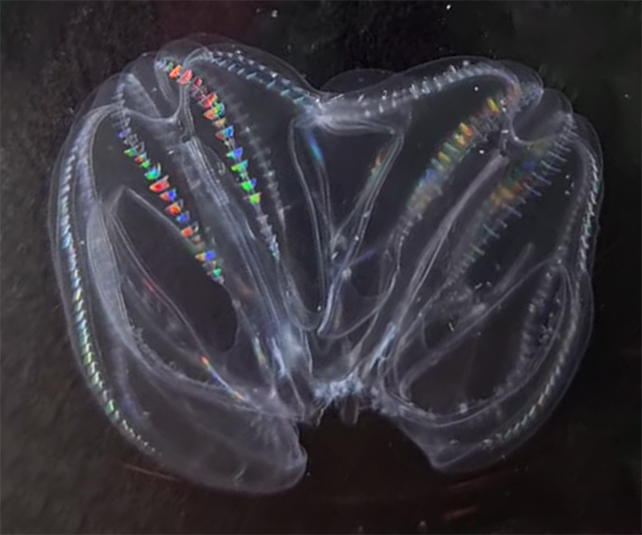These Freakish Ocean Creatures Can Combine as One When Injured
When injured, pairs of comb jellies can seamlessly fuse together to become one fully functioning entity – like Frankenstein’s monster in reality.
Researchers in the UK accidentally stumbled across this freaky ability when they found a two-butted, oddly large individual among their group of captive sea walnuts (Mnemiopsis leidyi).
Poking what used to be a solitary half of the now fused individuals caused the whole conjoined creature to flinch in response, as captured in the unsettling video below. This suggests the once-separate nervous systems are now fully integrated with each other, the researchers explain.
“I was surprised when the muscle contractions of the fused comb jellies became synchronized,” University of Exeter bioscientist Kei Jokura told ScienceAlert.
It wasn’t just a melding of nervous systems. Their digestive systems had fused as well.
“The fused comb jellies have two mouths,” explains Jokura. “When food was given to one side, the digested material was transported to the neighboring digestive tract.”
The resulting poop was expelled from both of their retained butts, interestingly at different times.
Some species of comb jellies (Ctenophores) like the sea walnut have rapid regenerative abilities, which is why they’ve become a popular laboratory model for wound healing. Previous studies have found sea walnut’s tissues graft easily onto each other, so Jokura and a team of international researchers tested a hunch to replicate their bizarre discovery.
They injured a number of sea walnuts, taking a slice along each one’s side lobes and keeping them isolated in pairs overnight. The next day they found nine of the ten pairs of M. leidyi had fused seamlessly into a single body.
On closer observation the researchers initially saw each member of the merged jellies move independently, but by two hours into their newly conjoined existence the majority of their muscle contractions were synchronized.
This suggests their nerve nets – comb jelly’s simple nervous systems – are now fully integrated with each other.

The researchers have yet to confirm if sea walnuts can also pull off this astonishing stunt in the wild. This species of Ctenophore floats freely among the planktonic life on the ocean’s vast surface, so they likely don’t find themselves close enough to a potential fusion partner that often.
But Jokura and team do have some theories as to why having the ability to fuse might give them an evolutionary advantage.
“One possible advantage is that fusion allows for a much faster recovery from injury compared to regeneration,” Jokura told ScienceAlert.
The biological fusions still appeared perfectly healthy three weeks after their merger.

Despite their name and gelatinous forms, comb jellies – known for their dazzling, rainbow-refracting, hair-like tentacles – are only distantly related to true jellyfish. These predators are found from the surface to the depths of the ocean and range in size from a few millimeters to around 1.5 meters.
Ctenophores are part of such an ancient lineage of animals that their ancestors are leading contenders for the first multicellular animal to have ever existed on Earth.
The ability of individual jellies to fuse so completely with each other suggests they lack the mechanisms most other animals have of recognizing ‘self’ from ‘non-self’. This allorecognition is what makes blood and organ donations so challenging between humans.
“Considering the evolutionary position of comb jellies, they might lack the genes necessary for allorecognition, but this is not certain,” explains Jokura. “I believe the evolution of allorecognition mechanisms may be deeply related to the evolution of multicellular animals.”
Jokura is now keen to learn about the mechanisms behind how the two individual animals’ neural activity combines so effectively.
“The allorecognition mechanisms are related to the immune system, and the fusion of nervous systems is closely linked to research on regeneration,” Jokura says in a press release. “Unraveling the molecular mechanisms underlying this fusion could advance these crucial research areas.”
This research was published in Current Biology.
